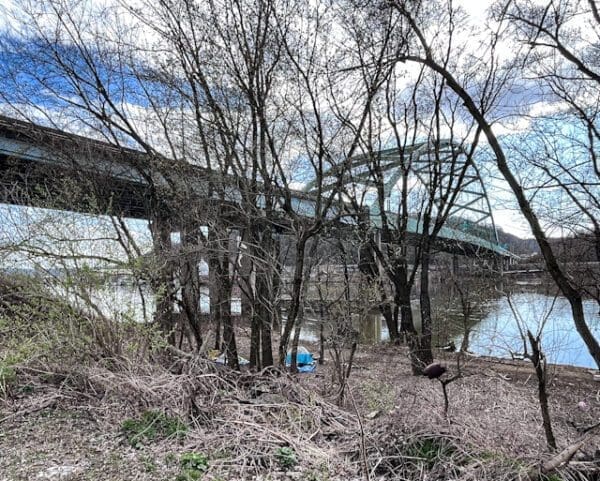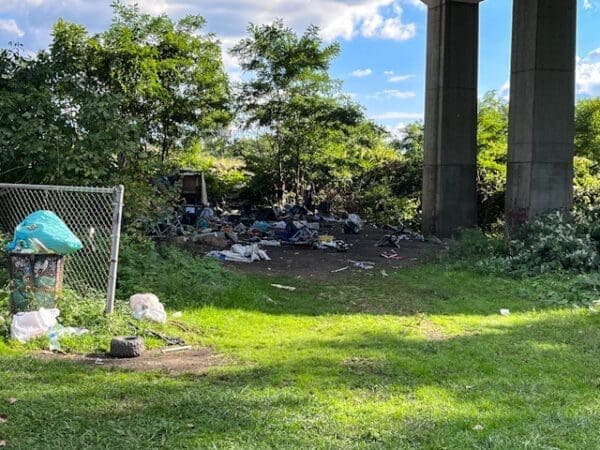
(Publisher’s Note: This article was published a little more than a year ago, and unfortunately the same search for answers continues today. The City of Wheeling enacted a camping ban at the beginning of the year and police officers have enforced it on several occasions because some homeless individuals have refused to reside in the exempted area near East Wheeling.)
There was a man who lived under the Market Street Bridge in Center Wheeling for two years without anyone really knowing he was there.
His shelter was sturdied by scraps of plywood, his floor was partially carpeted, and his fireplace was small and purposely directional for personal heat only. He was homeless because he experienced financial hardship but, according to Dr. Bil Mercer of Project Hope, the man eventually qualified for public housing and has since moved on with his life.
“He’s one of our best success stories,” said Mercer, a recent “public service” inductee into the Wheeling Hall of Fame. “But after he left the area for his new home, other people moved in under the bridge and that’s when the big fire happened that closed the bridge last summer, and that was because of a turf battle; one group going against another.

“That’s happened more than once here, and once a camp has been ransacked and cut up, the only option is to clear it out,” said Mercer. “But we’ve also had homeless encampments cleared here for no reason other than it exists, and those clearings have only hurt the people who are just trying to survive.”
The Market Street Bridge remains closed with no timeframe for reopening announced by the W.Va. Division of Highways. The bridge, constructed with an experimental polymer material, was damaged by the large blaze and was immediately blocked to traffic. A more recent nighttime fire was reported this past week under the Chapline Street Bridge, and fire investigators reported signs of a homeless encampment beneath the span.
“There are not many good situations when it involves homelessness, and every situation is different, that’s for sure,” Mercer said. “I just hope we can do better this year when it comes to clearing camps again because there is data that shows that when an encampment is cleared, the health issues get much worse.
“I just think we have to remember that mental health and drug abuse play factors with what happens in these camps. I know some people don’t remember a thing about what has happened because they were on meth at the time. It’s not a good situation for anyone.”

Ever Changing Faces
There are nearly 600,000 Americans experiencing homelessness today in the United States, and the numbers only have risen during the last decade, according to the federal Centers for Disease and Prevention. California and New York possess the top two homeless populations. West Virginia is 43rd and Ohio is ranked 10th.
The Buckeye State, the CDC reported, has slightly more than 10,000 people who live homelessly, and West Virginia registered under 1,500 residents without homes. The East Wheeling and downtown areas are populated by a number of non-profits that offer homeless services, including the Catholic Charities Neighborhood Center, the Greater Wheeling Soup Kitchen, Youth Services System, the House of Hagar, and the Wheeling Homeless Coalition.
The country’s drug epidemic is a primary reason for homelessness, Mercer said, and so are mental health, poverty, and domestic violence. Very rarely has Mercer encountered people living homeless in Wheeling because they WANT to live homeless in Wheeling.

“We have some young homeless now who have told us they’ve made the decision not to work and pay bills like everyone else and instead live in a tent and eat for free,” the general physician said. “We don’t get a lot of it, but some have said they are here because everything is free. Some people love living in their tents and once you’ve done that for five or six years, it is your new normal.”
The vast majority of those currently living along the banks of the Ohio River and Big Wheeling Creek, or along the hillside above East Wheeling, are between the ages of 26 and 38, Mercer estimated. This spring, though, the doctor has noticed an infusion of youth.
“One reason we see younger people living in the tents now is because if you are homeless, you don’t live very long. We had 13 deaths last year,” he reported. “I have not known too many of our homeless who have gotten past the age of 58, and this year we’re seeing a lot of people in their 20s and their 30s because some are runaways and some made the mistake of getting into the drugs at early ages.
“Like I said, I just hope we can do better this year,” Mercer added. “I hope we can help more people than we ever have before.”

